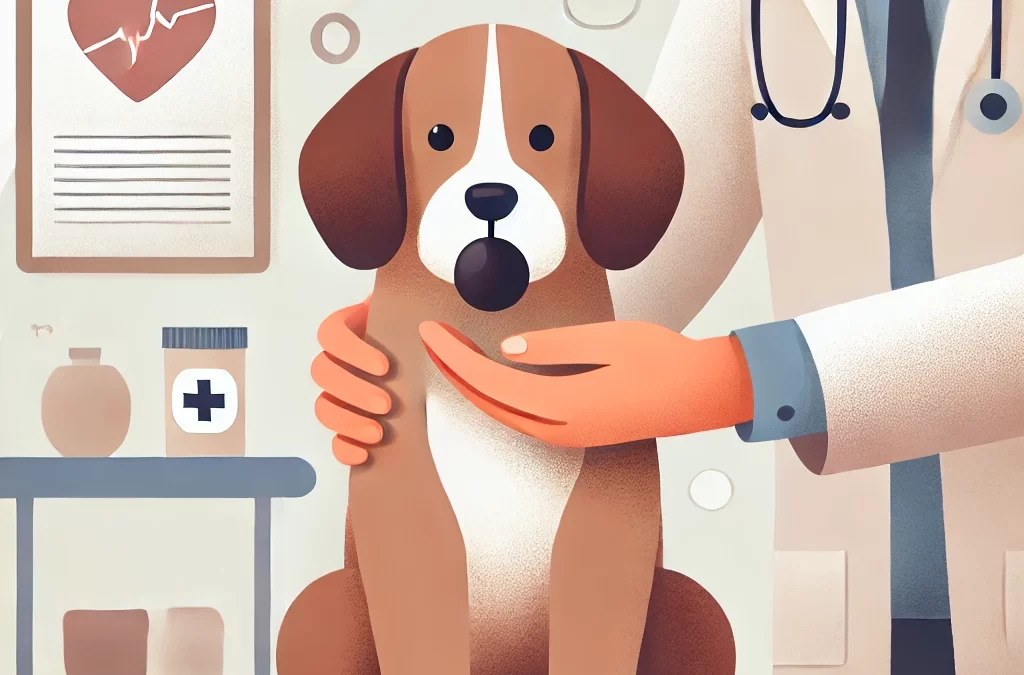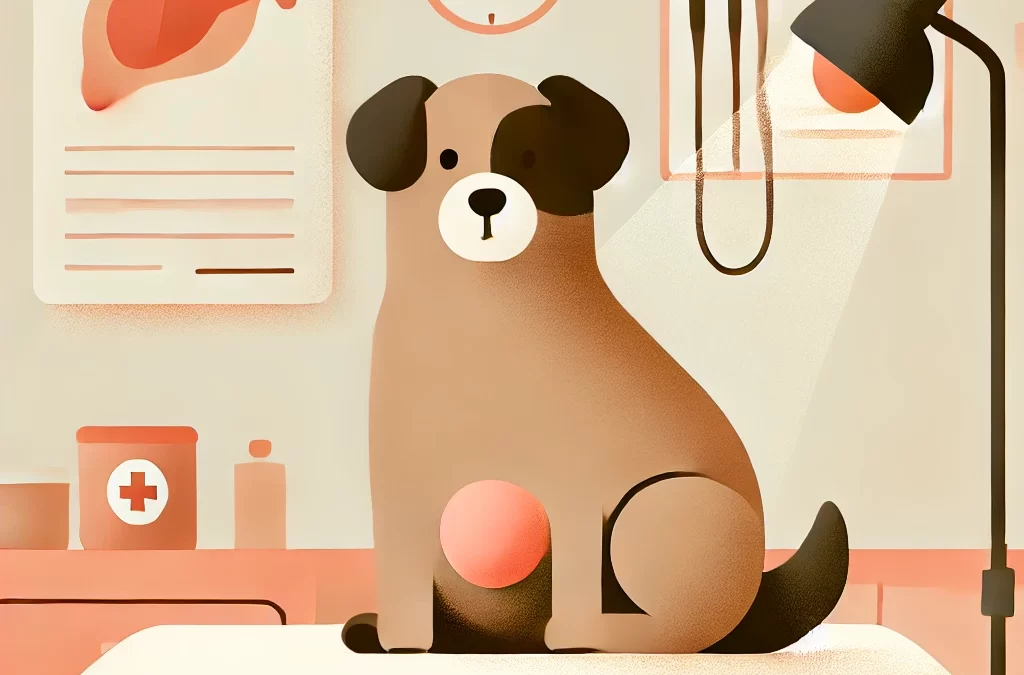
da TCMVET | 20 dicembre 2024 | Cancro e tumori del cane
Il cancro nei cani è da tempo motivo di preoccupazione per i proprietari di animali domestici. Sebbene sia naturale sentirsi sopraffatti quando ci si trova di fronte a questa diagnosi, comprenderne le cause può offrire spunti di riflessione sulla prevenzione e la cura. Questo articolo approfondisce le potenziali cause del cancro nei cani, facendo luce su fattori genetici, ambientali e legati allo stile di vita.
Predisposizione genetica: un motore silenzioso
Uno dei motivi principali per cui i cani sviluppano il cancro è la genetica. Alcune razze sono più inclini al cancro a causa di tratti ereditari. Ad esempio, Golden Retriever, Boxer e Rottweiler sono noti per avere una maggiore probabilità di sviluppare tumori come linfoma e osteosarcoma. Questa predisposizione genetica evidenzia l'importanza di pratiche di allevamento responsabili per ridurre al minimo il rischio.
Tossine ambientali: minacce invisibili
I cani sono spesso esposti a tossine ambientali senza che i loro proprietari se ne accorgano. Pesticidi, erbicidi, fumo passivo e persino prodotti per la pulizia della casa possono contribuire allo sviluppo del cancro. L'esposizione prolungata a queste sostanze nocive può innescare mutazioni nelle cellule, portando infine alla crescita del tumore.
Dieta e obesità: alimentare il rischio
Una dieta povera, priva di nutrienti essenziali o ricca di cibi lavorati può indebolire il sistema immunitario di un cane, rendendolo più suscettibile al cancro. L'obesità aggrava ulteriormente il problema creando un ambiente infiammatorio nel corpo. Mantenere una dieta bilanciata ricca di antiossidanti ed evitare di sovralimentare può ridurre significativamente il rischio.
Invecchiamento: un fattore naturale
Con l'avanzare dell'età, le cellule dei cani subiscono usura e deterioramento, aumentando la probabilità di cancro. I cani più anziani spesso sperimentano un declino della funzione immunitaria, che consente alle cellule anomale di proliferare senza controllo. Ciò rende essenziali i controlli veterinari regolari per la diagnosi precoce e l'intervento.
Sovravaccinazione e fattori medici
Alcuni studi suggeriscono che la vaccinazione eccessiva o procedure mediche non necessarie potrebbero svolgere un ruolo nell'aumento del rischio di cancro. Mentre i vaccini sono fondamentali per prevenire le malattie, vaccinazioni eccessive o mal programmate potrebbero stressare il sistema immunitario di un cane. Consulta sempre un veterinario di fiducia per personalizzare un piano vaccinale adatto alle esigenze del tuo cane.
Esposizione al sole e danni da raggi UV
Per i cani con pelliccia chiara o pelo sottile, un'eccessiva esposizione al sole può causare il cancro della pelle, in particolare nelle aree con poca pigmentazione. Proteggere il cane con una crema solare adatta agli animali domestici o limitare le attività all'aperto durante le ore di massima luce solare può aiutare.
Come ridurre al minimo il rischio
- Nutrizione equilibrata: Fornisci una dieta di alta qualità adatta all'età, alla razza e al livello di attività del tuo cane. Includi fonti naturali di antiossidanti, come mirtilli e carote.
- Limitare l'esposizione alle tossine: Utilizza prodotti per la pulizia sicuri per gli animali domestici ed evita di esporre il tuo cane a pesticidi o fumo di tabacco.
- Esercizio regolare: Mantenere un peso sano attraverso una regolare attività fisica.
- Visite veterinarie di routine: Pianificare controlli e screening annuali per individuare precocemente potenziali problemi di salute.
- Piani di vaccinazione personalizzati: Collabora con il tuo veterinario per sviluppare un programma di vaccinazione adatto allo stile di vita e allo stato di salute del tuo cane.
Pensieri conclusivi
Il cancro nei cani è una malattia complessa influenzata da un mix di fattori genetici, ambientali e legati allo stile di vita. Sebbene sia impossibile eliminare tutti i rischi, adottare misure proattive può ridurre significativamente la probabilità di cancro. Restando informati e attenti, i proprietari di animali domestici possono fornire ai loro compagni pelosi la migliore assistenza e qualità di vita possibili.

da TCMVET | 18 dicembre 2024 | Cancro e tumori del cane
Il linfoma è uno dei tumori più comuni nei cani e, sebbene possa spesso essere gestito con trattamenti come la chemioterapia, arriva un punto in cui la malattia può progredire nonostante gli interventi. Riconoscere i segnali che indicano che il tuo cane si sta avvicinando alla fine del suo viaggio può aiutarti a fornire conforto e a prendere decisioni informate sulle sue cure. Ecco una guida per comprendere i segnali del linfoma in fase avanzata e come supportare il tuo amato animale domestico durante questo periodo difficile.
Conoscere il linfoma canino
Il linfoma colpisce il sistema linfatico, che fa parte del sistema immunitario. Può manifestarsi in diverse parti del corpo, tra cui i linfonodi, la milza, il fegato e il tratto gastrointestinale. La progressione della malattia varia, ma man mano che avanza, il corpo diventa sempre più compromesso, portando a significativi cambiamenti fisici e comportamentali.
Segnali che il tuo cane potrebbe morire di linfoma
Grave affaticamento e letargia
I cani con linfoma avanzato spesso mostrano una stanchezza estrema. Il tuo animale domestico, un tempo attivo, potrebbe passare la maggior parte della giornata dormendo o sdraiato, mostrando scarso interesse per le attività che prima gli piacevano.
Respirazione difficoltosa
Il linfoma al torace può causare un accumulo di liquidi attorno ai polmoni, rendendo difficile la respirazione del cane. I sintomi includono respirazione rapida, respiri superficiali o sforzi faticosi.
Perdita di appetito
Un cane morente potrebbe rifiutarsi di mangiare o bere, il che indica che il suo corpo si sta spegnendo. Anche i suoi dolcetti preferiti potrebbero non essere toccati.
Perdita di peso e atrofia muscolare
Con il progredire della malattia, si evidenziano una significativa perdita di peso e un atrofia muscolare (cachessia). Le costole e la spina dorsale del cane possono diventare più pronunciate.
Linfonodi ingrossati
Sebbene i linfonodi ingrossati siano un segno distintivo del linfoma, le loro dimensioni possono aumentare notevolmente man mano che la malattia si avvicina alle fasi finali.
Vomito e diarrea
Se il linfoma colpisce il tratto gastrointestinale, il tuo cane potrebbe avere vomito cronico, diarrea o entrambi. Questi sintomi possono portare alla disidratazione e indebolire ulteriormente il corpo.
Dolore e disagio
Il tuo cane potrebbe mostrare segni di dolore, come piagnucolii, difficoltà a sdraiarsi o riluttanza a muoversi. Il dolore potrebbe derivare da danni agli organi, infiammazione o pressione causata da tumori.
Cambiamenti nel comportamento
I cani spesso diventano introversi quando si avvicinano alla fine della vita. Possono evitare l'interazione, cercare la solitudine o apparire disorientati.
Come supportare il tuo cane in questo periodo
Consulta il tuo veterinario per assicurarti che il tuo cane riceva un'adeguata gestione del dolore e cure palliative. Farmaci come anti-nausea, stimolanti dell'appetito e antidolorifici possono migliorare il comfort del tuo cane.
Crea un ambiente tranquillo e pacifico dove il tuo cane possa riposare senza essere disturbato. Forniscigli una cuccia morbida e tieni i suoi oggetti preferiti nelle vicinanze.
Offri piccole quantità di cibo facilmente digeribile se il tuo cane è disposto a mangiare. Anche l'idratazione è importante, ma non forzarlo a bere.
Trascorri del tempo di qualità con il tuo animale domestico, offrendogli affetto e rassicurazione. Essere presenti può offrire un immenso conforto sia a te che al tuo cane.
Prendi in considerazione l'eutanasia umana se la qualità della vita del tuo cane diminuisce in modo significativo. Sebbene sia una decisione difficile, può essere un modo compassionevole per alleviare la sua sofferenza.
Conclusione
Riconoscere i segnali che indicano che il tuo cane potrebbe essere in fin di vita a causa del linfoma ti consente di concentrarti sul suo comfort e benessere. Il percorso di ogni cane è unico e il tuo amore e la tua cura durante questo periodo faranno una differenza significativa nei suoi ultimi giorni.

da TCMVET | 18 dicembre 2024 | Cancro e tumori del cane
Introduzione: il nemico silenzioso nella cura del cancro canino
La cachessia cancerosa, una sindrome metabolica complessa caratterizzata da grave perdita di peso e atrofia muscolare, è una condizione silenziosa ma mortale che colpisce molti cani affetti da cancro. Spesso messa in ombra dalla malattia primaria, la cachessia ha un impatto significativo sulla qualità della vita, sulla risposta al trattamento e sulla sopravvivenza complessiva degli animali domestici colpiti. Comprendere e affrontare questa condizione è fondamentale per una cura olistica del cancro nei cani.
What is Cancer Cachexia?
La cachessia da cancro è più di una semplice perdita di peso. È una condizione multifattoriale guidata dall'interazione di infiammazione sistemica, disregolazione metabolica e richieste metaboliche del tumore. Le caratteristiche principali includono:
- Perdita di massa muscolare:A differenza della semplice fame, la cachessia provoca una perdita di massa muscolare che non può essere invertita con il solo aumento dell'apporto calorico.
- Appetite Changes: I cani possono mostrare un interesse ridotto per il cibo (anoressia) o preferenze di gusto alterate.
- Infiammazione sistemica:L'infiammazione indotta dal tumore esacerba gli squilibri metabolici, peggiorando ulteriormente la condizione.
Perché la cachessia cancerosa si verifica nei cani?
I meccanismi esatti della cachessia cancerosa sono complessi e variano a seconda del tipo e dello stadio del cancro. I fattori che contribuiscono a questa condizione includono:
- Tumor Metabolism: Alcuni tumori secernono sostanze che interferiscono con i normali processi metabolici, causando la degradazione dei muscoli e dei grassi.
- Citochine e ormoni: L'aumento dei livelli di citochine pro-infiammatorie (ad esempio, TNF-alfa) e gli squilibri ormonali svolgono un ruolo fondamentale nel determinare la cachessia.
- Carenze nutrizionali: Una ridotta assunzione di cibo e un assorbimento alterato dei nutrienti peggiorano le condizioni del cane.
Riconoscere la cachessia cancerosa nei cani
La diagnosi precoce è fondamentale per gestire la cachessia da cancro. Cerca questi segnali:
- Perdita di peso inspiegabile nonostante un'adeguata assunzione di cibo
- Atrofia muscolare, soprattutto attorno alla colonna vertebrale e alle zampe posteriori
- Stanchezza e livelli di attività ridotti
- Cambiamenti nell'appetito o nel comportamento alimentare
Strategie di gestione innovative
Sebbene non esista una soluzione valida per tutti, un approccio multimodale può aiutare a gestire la cachessia nei cani. Ecco alcune strategie emergenti:
- Supporto nutrizionale personalizzato:Una dieta ricca di proteine di alta qualità, acidi grassi omega-3 e amminoacidi specifici come la glutammina può aiutare a preservare la massa muscolare.
- Appetite Stimulants: Farmaci come la mirtazapina o la capromorelina possono migliorare l'appetito e l'assunzione di cibo.
- Anti-Inflammatory Therapies:Gli integratori di Omega-3 e i farmaci che agiscono sui percorsi infiammatori possono ridurre l'attività delle citochine.
- Modulatori metabolici:La ricerca su farmaci come l'anamorelina e i mimetici della grelina si dimostra promettente nell'invertire l'atrofia muscolare.
Il ruolo della medicina integrativa
Le terapie naturali, come la medicina tradizionale cinese (MTC), hanno mostrato potenziale nell'alleviare i sintomi. Erbe come l'astragalo e il ginseng possono supportare la funzione immunitaria e i livelli di energia, mentre l'agopuntura può migliorare l'appetito e ridurre l'infiammazione.
Guardando al futuro: la necessità di ulteriori ricerche
Nonostante i progressi, la cachessia cancerosa resta poco studiata in medicina veterinaria. Gli sforzi collaborativi tra veterinari, ricercatori e proprietari di animali domestici sono essenziali per sviluppare nuove terapie e migliorare i risultati per i cani colpiti.
Conclusione: speranza attraverso l'innovazione
Sebbene la cachessia da cancro ponga sfide significative, i progressi nella comprensione e nella gestione di questa condizione offrono speranza. Adottando un approccio olistico e proattivo, possiamo migliorare la qualità della vita dei cani che combattono contro il cancro e aiutarli a godersi i loro anni d'oro con dignità e comfort.

da TCMVET | 16 dicembre 2024 | Cancro e tumori del cane
Il melanoma maligno orale (OMM) nei cani è un avversario furtivo. Noto per la sua natura aggressiva e la rapida diffusione, è una diagnosi che incute timore nei cuori dei proprietari di animali domestici. Ma l'OMM è più di una semplice condizione medica: è un invito all'azione per i genitori di animali domestici ad abbracciare vigilanza, innovazione e cure olistiche. Immergiamoci in questo argomento impegnativo con una nuova prospettiva, esplorando sia la scienza che la speranza.
Che cos'è il melanoma orale maligno?
Il melanoma maligno orale è un tipo di cancro che ha origine nei melanociti, cellule responsabili della produzione di pigmento nella pelle e nelle mucose. Sebbene si manifesti più comunemente nella bocca, questo cancro non si ferma lì. È noto per la sua capacità di invadere i tessuti circostanti e metastatizzare in organi distanti come i polmoni e i linfonodi.
Questa condizione è più diffusa nei cani di mezza età o anziani, in particolare nelle razze con gengive pigmentate di scuro, come Cocker Spaniel, Chow Chow e Scottish Terrier. Nonostante la sua triste reputazione, comprendere i segnali e le opzioni di trattamento dell'OMM può consentire ai proprietari di prendere decisioni informate.
Riconoscere i segnali
Il melanoma maligno orale spesso passa inosservato finché non è in fase avanzata, rendendo fondamentali i controlli orali regolari. I segni comuni includono:
- Una massa scura o irregolare nella bocca, nelle gengive o nelle labbra.
- Sanguinamento, alito cattivo o sbavatura.
- Difficoltà a mangiare, masticare o deglutire.
- Gonfiore del viso o linfonodi ingrossati.
Se noti uno di questi sintomi, consulta immediatamente il tuo veterinario. Una diagnosi precoce può avere un impatto significativo sui risultati.
Oltre i trattamenti tradizionali: abbracciare l'innovazione
I trattamenti convenzionali per l'OMM includono chirurgia, radioterapia e chemioterapia. Sebbene efficaci in molti casi, queste opzioni non sono sempre accessibili o convenienti. Ecco alcuni approcci innovativi e integrativi che stanno guadagnando attenzione:
- Vaccini immunoterapeutici: Un punto di svolta in oncologia, i vaccini specifici per OMM, come il vaccino contro il melanoma canino (ONCEPT®), stimolano il sistema immunitario del cane a combattere le cellule tumorali. Questo trattamento all'avanguardia ha dimostrato di essere promettente nell'estendere i tempi di sopravvivenza.
- Terapia fotodinamica (PDT): Questa tecnica utilizza farmaci attivati dalla luce per distruggere selettivamente le cellule cancerose, risparmiando il tessuto sano circostante. È un'opzione meno invasiva per alcuni casi.
- Integratori olistici: Integratori naturali come la curcumina (presente nella curcuma), i funghi medicinali e gli acidi grassi omega-3 sono oggetto di studio per le loro proprietà antinfiammatorie e immunostimolanti. Consultare sempre un veterinario prima di incorporare integratori.
Il ruolo della dieta nel recupero
Una diagnosi di cancro richiede un cambiamento nelle strategie dietetiche. I cani che combattono l'OMM traggono beneficio da una dieta su misura per le loro esigenze metaboliche. Concentratevi su:
- Proteine di alta qualità: Carni magre e pesce per mantenere la massa muscolare.
- Grassi sani: Acidi grassi Omega-3 per combattere l'infiammazione e favorire la salute generale.
- Opzioni a basso contenuto di carboidrati: Le cellule tumorali prosperano grazie allo zucchero; limitare i carboidrati può aiutare a rallentarne la crescita.
I pasti fatti in casa e approvati dal veterinario possono essere un ottimo modo per garantire al tuo cane un'alimentazione ottimale.
Supporto emotivo e pratico per i genitori di animali domestici
Prendersi cura di un cane con OMM è tanto emotivamente impegnativo quanto impegnativo. Ecco come affrontare questo viaggio:
- Crea una routine di cura quotidiana: Creare coerenza può aiutare a ridurre lo stress sia per te che per il tuo cane.
- Cerca il supporto della comunità: I forum online e i gruppi di supporto locali per i proprietari di animali domestici che affrontano il problema del cancro canino possono offrire conforto e spunti preziosi.
- Esplora le opzioni di cure palliative: Se il trattamento curativo non è un'opzione, concentratevi sulla gestione del dolore e sul miglioramento della qualità della vita del vostro cane.
Uno Sguardo di Speranza
Sebbene il melanoma maligno orale nei cani sia un nemico formidabile, i progressi nella medicina veterinaria e nelle cure integrate stanno cambiando la narrazione. La diagnosi precoce, i trattamenti innovativi e l'attenzione al benessere olistico stanno dando ai genitori di animali domestici gli strumenti per combattere questa malattia.
La diagnosi del tuo cane non definisce il viaggio: è un capitolo nella storia della sua resilienza, del suo amore e del legame che condividete. Continua a fare domande, a cercare soluzioni e ad apprezzare ogni momento.

da TCMVET | 16 dicembre 2024 | Cancro e tumori del cane
Scoprire un nodulo sullo stomaco del tuo cane può essere allarmante. Come proprietari di animali domestici, il nostro primo istinto è spesso la preoccupazione, ma non tutti i noduli sono pericolosi. Infatti, molti sono benigni e gestibili con le cure appropriate. Per aiutarti a gestire questa situazione, ecco una nuova prospettiva su come comprendere, identificare e affrontare i noduli allo stomaco nei cani.
Cos'è esattamente un nodulo allo stomaco?
Un nodulo allo stomaco nei cani si riferisce a qualsiasi massa anomala o gonfiore nella zona addominale. Questi possono variare in dimensioni, forma e consistenza: alcuni sono morbidi e mobili, mentre altri possono essere sodi o attaccati ai tessuti sottostanti.
La chiave per gestire questi grumi sta nell'osservazione e nell'azione tempestiva. Prima di trarre conclusioni affrettate, esploriamo le cause più comuni dietro queste escrescenze.
Cause comuni di grumi allo stomaco
- Lipomi (tumori grassi): Si tratta di noduli benigni, morbidi e a crescita lenta, che si trovano comunemente nei cani anziani. I lipomi raramente rappresentano un rischio per la salute e sono solitamente più un problema estetico.
- Ematomi o ascessi: Se il tuo cane ha subito un trauma di recente, il nodulo potrebbe essere un ematoma (un accumulo di sangue sotto la pelle) o un ascesso causato da un'infezione. Questi sono spesso caldi e sensibili al tatto.
- Ernie: Le ernie si verificano quando i tessuti o gli organi interni spingono attraverso un punto debole nella parete addominale. Possono essere morbide al tatto e ridursi se premute delicatamente.
- Tumore maligno: Sfortunatamente, alcuni noduli sono cancerosi. I tumori dei mastociti, i sarcomi dei tessuti molli e altre neoplasie maligne spesso richiedono cure e cure veterinarie immediate.
- Cisti o escrescenze delle ghiandole sebacee: Si tratta spesso di sacche piene di liquido o ghiandole ostruite che possono comparire sullo stomaco del tuo cane. Sono generalmente innocue, ma potrebbero richiedere drenaggio o un piccolo intervento chirurgico se diventano troppo grandi.
Segnali che richiedono attenzione immediata
Sebbene non tutti i noduli allo stomaco siano motivo di preoccupazione, alcuni sintomi segnalano la necessità di una visita urgente dal veterinario:
- Il nodulo aumenta rapidamente di dimensioni.
- Quando tocchi la zona interessata, il tuo cane sembra provare dolore.
- Il nodulo è duro, immobile o di forma irregolare.
- Si verificano arrossamenti, gonfiori o secrezioni nella zona interessata.
- Il tuo cane mostra segni di letargia, perdita di appetito o altri problemi sistemici.
Cosa fare se si scopre un nodulo
- Monitorare il nodulo: Tieni traccia delle sue dimensioni, della sua consistenza e del suo comportamento. Scattare foto ogni pochi giorni può aiutarti a notare eventuali cambiamenti.
- Prenota una visita dal veterinario: Il veterinario può eseguire un esame fisico e potrebbe raccomandare test diagnostici come un'aspirazione con ago sottile, una biopsia o un'ecografia per determinare la natura del nodulo.
- Considerare le opzioni di trattamento: A seconda della diagnosi, il veterinario potrebbe suggerire osservazione, farmaci, intervento chirurgico o altre terapie. Per escrescenze benigne come i lipomi, il trattamento potrebbe non essere necessario a meno che il nodulo non causi fastidio.
- Esplora i rimedi naturali (con approvazione del veterinario): Per le escrescenze non maligne, alcuni proprietari di animali domestici si rivolgono a integratori naturali come curcuma, acidi grassi omega-3 o trattamenti a base di erbe che promuovono la salute immunitaria generale. Consulta sempre il veterinario prima di introdurre qualsiasi nuovo integratore.
Consigli di prevenzione per un cane sano
- Controlli regolari: La diagnosi precoce è fondamentale per gestire efficacemente i noduli. Visite regolari dal veterinario assicurano che eventuali cambiamenti vengano affrontati tempestivamente.
- Dieta bilanciata: Una dieta ricca di nutrienti può supportare la salute generale e il sistema immunitario del tuo cane.
- Mantenere un peso sano: L'obesità aumenta il rischio di tumori grassi e altri problemi di salute. Mantieni il tuo cane attivo e a un peso ideale.
- Cura della pelle: Una toelettatura e un'ispezione regolari del pelo e della pelle del tuo cane possono aiutarti a individuare precocemente eventuali anomalie.
Una parola di conforto
Non tutti i noduli sono pericolosi per la vita e i progressi della medicina veterinaria hanno reso la diagnosi e il trattamento più efficaci che mai. Restando attenti e proattivi, puoi garantire che il tuo cane rimanga felice e sano.
Se noti un nodulo allo stomaco, fai un respiro profondo e contatta il tuo veterinario. Insieme, troverete la strada migliore per il tuo compagno peloso.
Tag: nodulo allo stomaco del cane, cause dei noduli nei cani, trattamento dei noduli nei cani, cura della salute del cane, tumori benigni nei cani, rimedi naturali per cani





